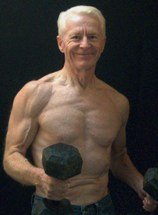Hi

A History in
Barbell Basics
It may come as a surprise to some, but neither Steve Reeves nor Arnold Schwarzenegger invented pumping iron. In fact, it is an ancient training concept with origins in southern Italy, about 500 B.C., by a man named Milo. People before him had exercised by lifting heavy objects, but historians credit Milo as the first to really figure out the progressive method of strength training.
Good old Milo. What he did was shoulder a small calf one day and carry it the length of the stadium at Olympia. The story goes that he continued carrying the animal regularly until it was full-grown. Thus Milo got progressively stronger as the animal got progressively heavier.
Once you understand the story of Milo, you understand the foundation of all progressive resistance training, a.k.a. weight training, pumping iron, and so forth.
In a beginners’ training protocol, novices are started off with straight-line resistance progression. It works like this: The beginner does an exercise with a comfortable weight for, say, 12 repetitions. At each subsequent workout, one repetition is added. When 15 repetitions are reached, a little more weight is added at the next workout, but the repetitions drop back to 12. Then one keeps repeating the sequence.
Of course straight-line progression cannot go on forever. But the idea is to continue that approach for as long as you can. When it gets tougher to keep adding weight or reps, you may now have to give your body more time to adjust to greater demand by staying with the same weight and reps for two or three consecutive workouts. Then you move up again in resistance or reps.
It’s a great concept. But eventually everyone reaches a time when adding either more weight or more reps seems next to impossible. Fitness trainers may call it
a “sticking point” or reaching a “plateau.” Getting past sticking points or plateaus requires other tricks of the trade. Besides adding reps to a set or weight to a barbell, you may also . . .
- Add sets: If you have been doing, say, three sets of 12 reps, add another set and do four. Keep in mind, though, if too many sets are added, over-training is likely. Think it through: if you find you are not recovering (e.g. you’re still tired after a night’s sleep), you may be overdoing it. So ease up.
- Another method is to take shorter rests between sets: Suppose you are resting 90 seconds between sets. Cutting rest time in 10-second increments is also a form of progression.
Remember also that resistance progression is not exclusive to using free weights. The same principles can be applied when using exercise
machines, resistance bands, or doing bodyweight calisthenics.
Stay Healthy. Stay Fit.
Logan
Senior Exercise Central
Spread the word. If you like the newsletter, please forward it to a senior friend or acquaintance.
Photographs: Subscribers have asked when the newsletter photo at the top of the page and my website pictures were taken. Well, I was a mere 70 years old then. I’m 88 now. Though I remain active, I am no longer nearly as strong or muscular as I was 18 years ago. —LF
Are you on Facebook?
Check out the Senior Exercise Central page at . . .
https://www.facebook.com/GrayIronFitness
I search the Internet for senior health and fitness items. If you like what you see, please click the Like button. It helps me.
Newsletter Policy
The Gray Iron Fitness Newsletter is a free publication sent twice monthly to subscribers. The purpose is to provide honest and realistic fitness information for people age 50 and above.
I have never been paid or received compensation of any kind to write a positive review or endorse a product. If I say that I personally use a product or service, it is because I find value in it and have paid for it with my own money.
Like newspapers, magazines, and television, this newsletter and my website contain advertising and marketing links. Naturally, I am compensated for these.
The newsletter and website provide information to help users establish and maintain a fitness lifestyle. But fitness information is not the same as fitness advice, which is the application of exercise and dietary practices to an individual's specific circumstances. Therefore, always consult with your physician for assurance that fitness information, and
your interpretation of it, is appropriate for you.Your comments and questions are always appreciated. Simply click on the "Reply" bottom.
Sincerely,
Logan Franklin
The Gray Iron Fitness Newsletter
www.senior-exercise-central.com



